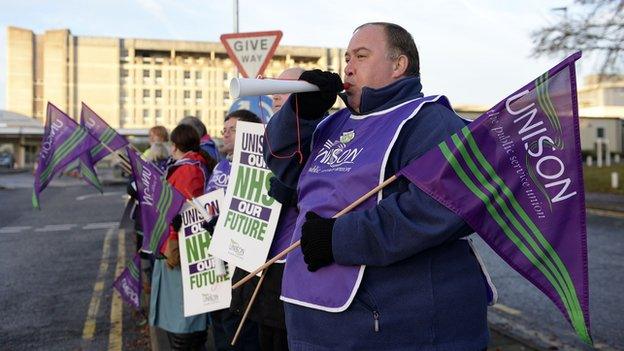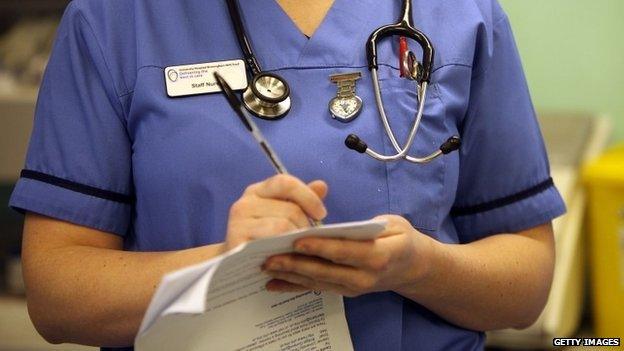NHS strike: A walkout with a difference
- Published
- comments

The words strike and NHS are enough to send a shudder down the spine of any patient.
But many of the people using the health service in England or Northern Ireland on Monday morning may not have noticed a huge difference.
Why? Walkouts in the NHS are quite different from other sectors. When tube drivers, council staff or teachers strike the aim is to cause disruption. It is the first rule of industrial action: make your contribution count.
However, the terms of engagement are somewhat different when NHS workers take part. While unions members want to make a point, they commit to not harming urgent and emergency services.
Ahead of this week's action local union officials held talks with managers to plan services - as they did before the walkout on 17 October. It means there are likely to have been many staff in work who supported the strike but have agreed to keep working.
Midwives are a classic example of this. The Royal College of Midwives has promised to keep maternity units running and so well over half of their members are believed to have worked.
And even where staff have walked out, there appears to have been a willingness to leave the picket lines when there has been a need.

What is the dispute about?
In a word, pay. Ministers in England and Northern Ireland have awarded NHS staff a 1% increase, but only for those without automatic progression-in-the-job rises.
These, designed to reward professional development, are given to about half of staff and are worth 3% a year on average.
What is more, the offer is "non-consolidated", which means it is taken away at the end of the year, meaning their pay packet returns back to the 2013-14 level, and does not count towards staff pensions.
An independent pay review board had said the 1% increase should be across the board and paid in full as normal.
Next year it has been suggested those not getting a progression-in-the job rise get 2%, but again it should be non-consolidated.
But in Scotland a 1% pay rise was given to everyone and in Wales a deal was reached last week after ministers agreed to pay 1% next year, while giving extra help to the lowest paid this year.

It means the disruption during both strikes seems to have been limited to areas such as outpatient appointments and community clinics.
And it is why unions are able to claim strong support for the walkout, while NHS England releases figures suggesting only about 12,500 staff - about one in 35 - did not turn up for work.
But with the strike now ended, attention turns to what happens next. The simple answer is a period of work-to-rule.
Members from the nine unions involved in the walkout are expected to take steps such as refusing to do unpaid overtime and insisting on taking their breaks. They may be joined by another two unions.
However, as far as an end to this dispute, a solution seems some way off. As the walkout was coming to an end, unions were already telling me they would be sitting down to discuss future action.
There was a meeting between the strike in October and this one, but it is thought little progress was made with the government maintaining giving a 1% pay rise on top of the progression-in-the-job pay rises was simply not affordable.
Unions have been told that they are free to come up with another solution, but that there is no more money for pay.

That means making some kind of compromise on the progression-in-the-job element. These can be extremely lucrative - for senior nurses and midwives they are worth £10,000 - so understandably staff are unwilling to give them up.
But to understand the cause of this dispute you really need to go back to 2009. That was the year the then NHS chief executive Sir David Nicholson set the health service an ambitious savings target.
The NHS was told to save £20bn by 2014 - later pushed back to 2015. Sir David was adamant, though, it could not simply be achieved through cuts, but rather it had to come from efficiency savings.
It works out as a productivity gain of between 4% and 5% a year - something the health service had never done before.
Unsurprisingly, it has turned out to be just as difficult as expected. A report by MPs earlier this year showed significant inroads had been made, but the majority of these had not come from efficiency savings.
Instead, the NHS had relied on "quick fixes" - namely pay restraint. Over the last four years there have been two years of freezes and two of small rises.
That has had a significant impact on the pockets of health workers. Figures from Unison suggest health worker pay has fallen by 10% during this period once inflation is taken into account.
But it is easy to understand - in simple money terms at least - why ministers have adopted such an approach. About 40% of the budget is spent on pay and with the NHS facing a £30bn hole in its finances by 2020, the government is under pressure to make resources stretch as far as they can.
That said, ministers know they face a tricky dilemma. Governments tend to avoid getting into disputes with health workers - public opinion normally sides with them - and so a lengthy period of industrial action ahead of an election will be something ministers will be keen to avoid.
Like all pay disputes, it promises to be a game of brinkmanship. But one in which the stakes could not be higher.